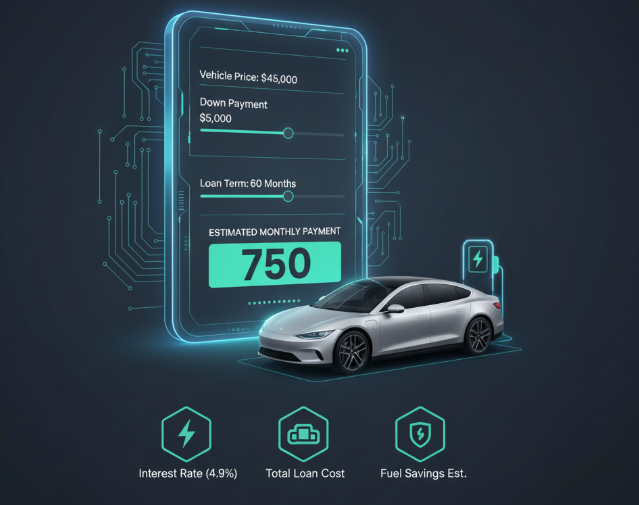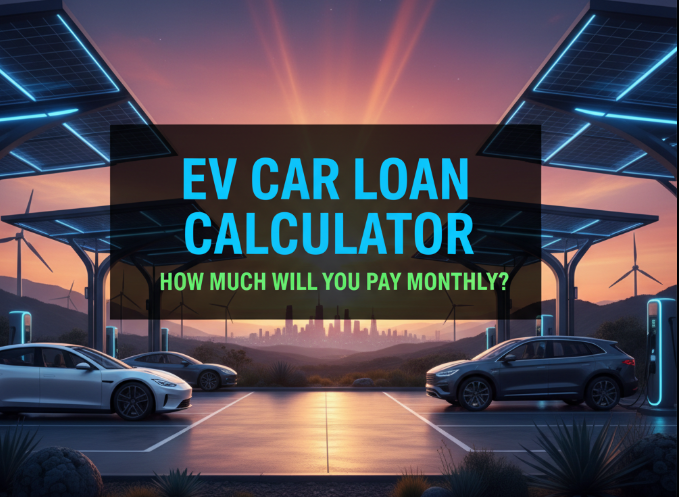Introduction: Why EV Car Loan Calculators Matter
Buying an electric vehicle (EV) is exciting—it’s modern, eco-friendly, and often cheaper to run than a gas-powered car. But there’s one question most people have before making the purchase: “How much will my monthly EV car loan payment be?”
That’s where an EV car loan calculator comes in. These tools help you estimate how much you’ll pay every month, based on factors like car price, down payment, loan term, and interest rate.
In this guide, we’ll go step by step through:
- How EV car loan calculators work
- What affects your monthly payments
- Sample calculations for different EV models
- Tips to reduce your monthly car loan bill
- Common mistakes people make when using these tools
By the end, you’ll know exactly how to use an EV loan calculator to make smarter financial decisions before buying your electric car.
How an EV Car Loan Calculator Works
An EV car loan calculator is a simple online tool that estimates your monthly payment. You enter some basic details, and it shows you how much you’ll likely pay each month.
Key Inputs You’ll Need:
- Car Price – The total cost of the EV before taxes or incentives.
- Down Payment – The amount you pay upfront (the more you pay now, the less you’ll owe later).
- Loan Term – How many months or years you’ll take to repay the loan (e.g., 36, 48, 60, or 72 months).
- Interest Rate (APR) – The percentage charged by the lender on the borrowed money.
- Taxes & Fees – Registration, documentation, and state taxes.
How It Calculates:
The calculator uses a standard loan formula that considers your loan amount, interest rate, and loan term. The result is your estimated monthly installment (EMI).
What Factors Shape Your Monthly EV Loan Payment
Your monthly bill doesn’t just depend on the car’s price. Several other elements play a role. Let’s break them down:
1. Vehicle Price & Model
- Higher-priced EVs like a Tesla Model S will naturally cost more per month than budget-friendly models like a Chevy Bolt.
- Advanced features, larger batteries, and premium trims also raise costs.
2. Down Payment Amount
- Paying 20% upfront can significantly reduce your monthly payment.
- A smaller down payment means you borrow more, increasing monthly costs.
3. Loan Term Length
- Short-term loans (36 months) = Higher monthly payments, less interest over time.
- Long-term loans (72 months) = Lower monthly payments, but you’ll pay more interest overall.
4. Interest Rate (APR)
- A buyer with excellent credit (750+ score) may qualify for 3–4% APR.
- Someone with a lower score (600–650) might get 7–12% APR, raising the monthly bill.
5. Government Incentives
- Federal tax credits (up to $7,500 in the U.S.) and state rebates can reduce your loan amount.
- Example: A $40,000 EV with a $7,500 rebate = Loan amount of $32,500 (if applied upfront).
Example EV Car Loan Monthly Payments
To give you a clear picture, here’s a table showing sample payments for different EVs. We’ll assume:
- Down Payment: $5,000
- Loan Term: 60 months (5 years)
- Interest Rate: 5%
| EV Model | Price ($) | Loan Amount ($) | Monthly Payment ($) | Total Paid Over 5 Years ($) |
|---|---|---|---|---|
| Nissan Leaf | 28,000 | 23,000 | 434 | 26,040 |
| Chevy Bolt EV | 32,000 | 27,000 | 510 | 30,600 |
| Tesla Model 3 (Base) | 40,000 | 35,000 | 661 | 39,660 |
| Ford Mustang Mach-E | 46,000 | 41,000 | 774 | 46,440 |
| Tesla Model S | 80,000 | 75,000 | 1,421 | 85,260 |
💡 Note: Actual monthly payments vary based on taxes, local incentives, and lender offers.
Graph: Impact of Loan Term on Monthly Payments
Imagine buying a $40,000 EV with a $5,000 down payment and 5% APR.
- 36 months: $1,050/month
- 48 months: $800/month
- 60 months: $661/month
- 72 months: $556/month
This graph would show how stretching your loan reduces your monthly bill but increases total interest paid.
How to Use an EV Car Loan Calculator (Step-by-Step)
Here’s a quick way to estimate your payments:
- Find the Car’s Price – Use MSRP or the dealer’s quoted price.
- Subtract Rebates & Incentives – Apply federal/state EV tax credits (if applicable).
- Choose Your Down Payment – Usually 10–20% of the car’s price.
- Enter Loan Term – Decide if you want a short or long-term loan.
- Add Interest Rate – Get a quote from banks, credit unions, or dealerships.
- Click Calculate – View your estimated monthly payment.
Tips to Lower Your Monthly EV Loan Payment
If your monthly bill feels too high, here are some proven strategies:
1. Increase Your Down Payment
- Pay more upfront to reduce your loan size.
- Example: A $5,000 vs. $10,000 down payment could cut payments by $100–$150/month.
2. Improve Your Credit Score
- Pay off credit card balances.
- Make on-time payments for 6+ months.
- A higher score unlocks better interest rates.
3. Compare Lenders
- Check rates from banks, credit unions, and online lenders.
- Credit unions often offer lower APRs than dealerships.
4. Consider a Longer Loan Term
- Extending from 60 to 72 months can reduce payments by $100+/month.
- But remember—you’ll pay more interest overall.
5. Look for Rebates & Discounts
- Federal tax credits, state rebates, and utility company incentives can lower the loan amount.
- Example: California’s Clean Vehicle Rebate saves up to $4,500.
Mistakes People Make with EV Loan Calculators
Even though calculators are helpful, many buyers misuse them. Here are common mistakes:
- Forgetting Taxes & Fees – Always include sales tax, registration, and dealer fees.
- Ignoring Insurance Costs – EV insurance can be slightly higher than gas cars.
- Overestimating Incentives – Some rebates apply only at tax time, not at purchase.
- Focusing Only on Monthly Payment – A smaller monthly bill might mean paying thousands more in interest.

Real-Life Scenarios
Let’s look at two quick examples to make things real:
Case 1: Student Buyer with Limited Budget
- Car: Nissan Leaf ($28,000)
- Down Payment: $3,000
- Loan Term: 72 months
- APR: 8% (average for limited credit)
Monthly Payment: Around $400
Total Paid Over 6 Years: About $32,000 (including interest)
Case 2: Professional with Strong Credit
- Car: Tesla Model 3 ($40,000)
- Down Payment: $8,000
- Loan Term: 60 months
- APR: 3.5% (excellent credit score)
Monthly Payment: Around $580
Total Paid Over 5 Years: About $34,800
Comparing Gas vs. EV Loan Payments
A unique way to look at EV affordability is by comparing it with gas car loans.
| Vehicle Type | Car Price ($) | Loan Amount ($) | Monthly Loan Payment ($) | Monthly Fuel Cost ($) | Total Monthly Cost ($) |
|---|---|---|---|---|---|
| Gas Car | 30,000 | 25,000 | 472 | 200 | 672 |
| EV Car | 32,000 | 27,000 | 510 | 50 (charging) | 560 |
👉 Even though the EV loan payment is slightly higher, the lower fuel cost makes EV ownership cheaper in the long run.
Frequently Asked Questions
1. Is an EV car loan calculator accurate?
Yes, calculators give a close estimate, but your lender’s final offer may differ depending on your credit profile and local taxes.
2. Can I use incentives directly in the calculator?
Yes. Subtract the rebate or credit from the car price before entering numbers.
3. Do all EVs qualify for tax credits?
No. Some high-end models and foreign-made EVs may not qualify. Always check eligibility.
4. Should I choose a long or short loan term?
- Short term: Pay less interest, higher monthly bill.
- Long term: Lower monthly bill, but more interest.
5. Where can I find an EV car loan calculator?
Most bank websites, credit unions, and auto loan comparison sites offer free tools.
Conclusion: Plan Smart Before You Buy
An EV car loan calculator is one of the simplest yet most powerful tools you can use before buying your electric car. It helps you:
- Predict monthly payments
- Compare loan options
- Factor in incentives and rebates
- Avoid surprises after purchase
If you’re considering an electric vehicle, don’t just look at the sticker price. Use a calculator, adjust the numbers, and see how different choices (like bigger down payments or shorter loan terms) affect your monthly budget.
With the right planning, your EV dream can become a financial reality without putting too much strain on your wallet.

Leave a Reply